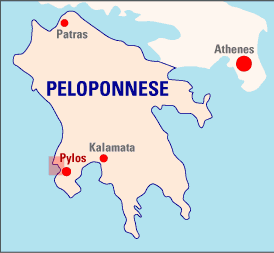
Archaeologists digging near the Palace of Nestor, at the southern tip of mainland Greece, have apparently excavated some fascinating contents from a 3,500 year old grave.
"Recently" in that sentence means the spring of 2015.
Three thousand and five hundred years ago means: the time of which Homer tells. The time which was already a distant heroic past to the classical Greeks.
So, what's the new finding?
For roughly 70 years now, the scholarly consensus has told of the sudden unexplained death of a Minoan civilization on Crete, and the rise of a successor, Mycenaean, civilization. This in turn has suggested invasion and overthrow.
The rich new findings from this grave suggest that there was nothing that dramatic, that there was a period of overlap during which Minoan and Mycenaean worlds existed side by side, distinct yet trading and peacefully co-existing.
"In other words," writes the Smithsonian's reporter, Jo Marchant, "it isn’t the Mycenaeans or the Minoans to whom we [westerners] can trace our cultural heritage since 1450 B.C., but rather a blending of the two."
Comments
Post a Comment